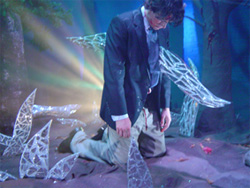Michele O’Marah

In an episode of the cult TV series The Twilight Zone, entitled ‘Queen of the Nile’ (1964), a curious but cynical journalist interviews a youthful-faced actress regarding her recent portrayal of Cleopatra. Suspicious of his interlocutor, the journalist probes his subject on a topic she avoids: her uncanny resemblance to an actress who has previously played the same role. Of course, these actresses are discovered to be one and the same, and our inquisitive stringer is left dead and bloodless, nutrition for the eternal queen.
Michele O’Marah’s recent show at Sister featured her new video, Faustus’s Children (2006), created in collaboration with David Jones (script and sound) and Tim Jackson (special effects), which was projected in a small back room. Getting to the video was thus a matter of shuffling through the set design, redeployed in the gallery: a single living-room complete with couch, fireplace, side-tables and walls adorned with decoy ducks and garish, almost narcotic wallpaper. The openness of this cinematic artifice is not without effect. In fact, it expresses O’Marah’s signature style of video-making, one that does not hide its low-tech, hand-crafted illusion. The wallpaper appeared to be made of construction paper, and the décor was little more than a generic painting-by-numbers domestic interior. In Faustus’s Children this simplicity remains what it is: a mere backdrop for a narrative saturated with a desire to speak to something beyond the filmic apparatus and to its effect on the bodies portrayed.
A loose adaptation of Goethe’s version of the Faust legend, which was itself an adaptation of numerous previous theatrical and folk accounts of the ultimate devil’s bargain, O’Marah’s video is a remake of remakes, adding to the many narrative appropriations already present in her earlier Valley Girl (2002). With the story of Faust, however, there is no one original, just a series of tropes and archetypes whose presence can be found everywhere from Hitchcock’s Rope (1948) to the Countess of Castiglione’s narcissistic, photographic play with mirrors, to Franz Werfel’s Der Spiegelmensch (The Mirror Man, 1921), all obliquely referenced by the artist.
O’Marah’s narrative resolves around the story of five young men, each of whom appears to be an upstate New York variant of Ryan Phillipe’s Sebastian in his 1999 film Cruel Intentions. Over heady chatter the boys decide to murder one of their friends just for the thrilling sensation of having control over life. After the arrival of a single young woman, the characters are knocked off one by one. Driven to wandering in the woods where the first victim was slain, each is lured away to his doom by a supernatural spectre (signalled on-screen by a shimmering crystalline mobile of mirrored bird-like objects and spooky sound effects).
Although the characters are portrayed by a cadre of local art-world figures, these could be any non-actors, replicated on screen and mesmerized by the shimmering reflected light of the mirrored spectre: the cinema screen as endower of eternal life. This is a fountain of youth previously engaged by video, specifically David Askevold’s Very Soon You Will (1977), where the off-screen voice (a narrator standing in for the artist) lulls a female subject into a hypnotic trance. Her eyes closed, her head the only visible presence on screen, she is literally narrated to the point of her own death, her transcendence eternalized by videotape. O’Marah’s own authorial presence remains veiled, discernible perhaps only in the spectre, identifying the camera as a murderous instrument, and the videotape as an endlessly looped life.
The final moment of O’Marah’s video frames the female actor’s face, mystifyingly resurrected. It is a puzzling coda, an indication of the inscribed living body on the live videotape. Unlike Dara Birnbaum in her video Damnation of Faust (1983), O’Marah does not frame her subject through appropriation; she makes the narrative her own. Rather than focus on mediated façades, she relishes the possibility of surface, exaggerating its presence through raw simplicity, amateur efforts and craft. There is no disguising the illusion. O’Marah’s work readily inhabits and moves comfortably within the body of theatrical artifice, allowing her to unlock the various transfigurations that are perhaps elemental to video.
















